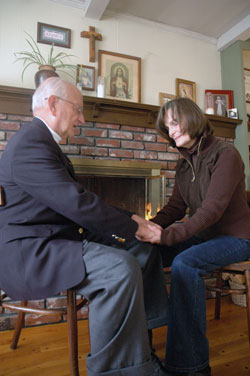Saved by hope:
Patient, doctor bring together hope in medicine and Christ

Dr. Hans Geisler and Kathy Hirsch, both members of St. Luke Parish in Indianapolis, pray on Jan. 16 in Hirsch’s home. From 2002-2004, Geisler treated Hirsch for stage-three ovarian cancer. They brought together in that treatment their hope in modern medicine and hope in Christ.
(Photo by Sean Gallagher)
Editor’s note: The following is the
second of two articles about how Christian hope, which was the subject of Pope Benedict XVI’s recent encyclical letter, “Spe Salvi,” plays an important role in the life of Catholics in the
archdiocese.
By Sean Gallagher
Hope in things both big and small keeps us going from day to day.
But there are times when hope seems to disappear and life comes crashing to a halt.
Kathy Hirsch faced such dark times five years ago when she was diagnosed with stage-three ovarian cancer and was told that she only had a 20 percent chance of living for another two years.
Despite this prognosis, Hirsch, a member of St. Luke the Evangelist Parish in Indianapolis, still had hope in the
medical expertise of her gynecological oncologist, Dr. Hans Geisler.
But, more importantly, she integrated that hope for this world with her hope in Christ and joined her sufferings to his.
Offer it up
In his encyclical “Spe Salvi” (“Saved by Hope”), Pope Benedict XVI reflected at some length about maintaining hope in the midst of suffering.
“It is not by sidestepping or fleeing from suffering that we are healed, but rather by our capacity for accepting it, maturing through it and finding meaning through union with Christ, who suffered with infinite love” (#37).
But at the end of these reflections, the pope adds a practical suggestion.
He briefly discusses the hope to be found in reviving “a form of devotion … perhaps less practiced today but quite widespread not long ago,” namely, offering up the ordinary trials and inconveniences of one’s everyday life in union with Christ’s suffering on the cross (#40).
The pope suggested that we can “insert these little annoyances into Christ’s great ‘com-passion’ [literally, to suffer with] so that they somehow [become] part of the treasury of compassion so greatly needed by the human race. In this way, even the small inconveniences of daily life could acquire
meaning and contribute to the economy of good and of human love” (#40).
Hirsch’s sufferings were far from common everyday annoyances. But she and her husband, Mike, found joy in knowing that her patient bearing of her condition could, when joined to Christ’s sufferings, bring about great good for others.
“That was where our joy came from, our hope came from,” she said. “We were able to offer everything we went through for holiness for our children.
“… We could [also] offer it for our community, for their families and their children, and for all of these people who were praying for us, for their families and for their children.”
Hirsch offered it up through three major surgeries and chemotherapy treatments that went on for nearly two years.
At the end of those two years, instead of dying, she was declared clear of her cancer.
‘It was the hand of the Lord’
Before she was diagnosed with ovarian cancer but after she knew that she was suffering from “something big,” Hirsch knew that she wanted to be treated by “a praying, Catholic doctor.”
She ended up choosing Geisler, one of her fellow St. Luke parishioners.
Geisler practiced gynecological
oncology in Indianapolis for nearly 40 years, retiring in 2004.
During that time, he saw his field progress by leaps and bounds.
At first, he said he was tempted, in a sense, to place hope in medical knowledge over and against hope in Christ instead of seeking to integrate the two, an approach the pope suggested in his encyclical.
But as the years went on, Geisler’s life of faith increased to a point where he felt humbled when patients would return to him to thank him for healing them.
“I would tell them that it wasn’t I that affected the cure, that it was the hand of the Lord,” Geisler said. “God works through physicians and works through modern science, and that all of these things are good, but ultimately it’s God.
“If we don’t have any belief in a life hereafter and a final union with God, all of life is fairly meaningless.”
This faith-filled perspective on his profession led him to be willing to pray with his patients, something he did regularly with Hirsch.
But Geisler learned lessons in hope as much, if not more, from patients who died while under his care than from those who ultimately survived.
“I think that patients, especially when they’re dying, taught me an awful lot,” he said. “They taught me how to go through suffering and how you can handle that as a human being.”
Whether she survived her own cancer or not, it was hope that kept Hirsch going.
“I think hope was everything,” she said. “I honestly, deeply believe that hope not only incites my desire for Christ, it fulfills my desire for Christ … ” †
